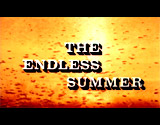
|
The Endless Summer (1966)
In narrator/director Bruce Brown's ultimate, low-budget
surfing-sport documentary and travelogue - it was accentuated by
music from the surf-rock instrumental group The Sandals, including
their title theme song. Surfing (as a state of mind and as a thrilling
but challenging sport & activity) became a national craze due
in part to this film. Brown's film summarized the varieties of ways
to enjoy the sport of surfing.
The narrator's non-chalant, deadpan, often-joking voice-over
with numerous cheerful quips (both intentional and unintentional)
accompanied the travels of a laid-back surfing duo around the world
looking for the best surfing spots - and experiencing an 'endless
summer.' They were on a search for the perfect surf ride on a wave: "With
enough time and enough money, you could spend the rest of your life
following the Summer around the world." Strangely however, the
two stars of the film were never heard speaking on camera. Also, the
film did not follow the actual progression of the two surfers leaving
Los Angeles and traversing eastward around the world through
Africa, Australia, New Zealand, and Tahiti before returning to the
US. It often interrupted itself with episodes about the exceptional
surfing in California and Hawaii's North Shore.
After shooting the film beginning in November 1963
(during a three month trip), director Brown struggled to find widespread
distribution for his amateurish film (with a self-financed budget
of $50,000). It was mostly regarded as a 'home-movie' (originally
shot on 16-mm film stock that was magnified to 35 mm for exhibition),
with post-synchronized sound. (Originally, the film had no audio,
but was supplemented by surf music and live narration.) And although
during its early promotional phase, it was popular during local screenings,
it was not picked up for a theatrical release. Eventually, Cinema
V distributed the film in 1966, and proved it was a tremendous success.
It grossed $5 million (domestic) and $20 million (worldwide).
The film's colorful poster with neon colors adorned
many college dorm room walls during the mid-60s. The final mention
in the film credits was a thank-you to King Neptune: "Special thanks
to Old King Neptune for providing the waves in this film." The
91 minute iconic film's main tagline was:
"In Search of the Perfect Wave"
This timeless film was followed years later with Brown's
own sequel The
Endless Summer II (1994) reflecting the widespread growth and
evolution of the sport (to include shortboards and body-boards),
and son Dana Brown's follow-up film The
Endless Summer Revisited (2000) with additional footage and interviews.
- the film's narrator, editor, and photographer Bruce
Brown described (with voice-overs) the popular summer sport of
surfing - on big or small waves, with either long boards or shorter
boards: "The sport of 'surfing'! The thrill and the fun of the sport of surfing.
Some people like to - body surf. Others like to ride a short belly
board and get a short ride. Still others like a short belly board
and a long ride. Most surfers like to ride a regular board and
perform on medium-sized waves. Some surfers prefer the hairy thrill
- of a big wave"
- Brown also colorfully described
how some rides ended up in a wipe-out: "You can go right or left,
but you can't very well do both at once -- if you do, it leads
to something commonly known in the surfing world as a "Wipeout"";
he also proposed one way to prolong the possibility of a wipe-out:
"The only way to avoid a wipeout is to take this wide
stink bug stance. Spread your legs and hang on till your trunks
rip - right up the back"
- during a short visit to surfing spots in the summer-time
in Hawaii, Brown noted that it was ideal: "Friendly surfers in
Hawaii. Hi there, Charlie. Conditions are idea. Water temperature
averaging 75 degrees, the air temperature, 75 degrees"; the narration
included a surfer's ultimate goal - to remain in the curl: ("The
ultimate thing to do in surfing is to be actually covered up by the wave")
- the next area to visit was California and some of
its ideal surfing locations - including the Malibu area: "California
has a lot of places that represent summer to a lot of people. No
place more than this secret spot. Malibu Beach, California, famous
for its Malibu outriggers, surfing, and girls. This is a girl.
And for those of you who are maladjusted, this is a Malibu outrigger";
he continued by describing the perfect position that surfers wanted to always maintain:
- "The main object in
surfing is to always remain in the curl. Stay as close as possible
to the white water without actually getting caught by it. All
the maneuvers in surfing: turning, stalling, trimming, riding
the nose, are directed toward the ultimate aim of staying in the curl"
- the film also visited the Santa Cruz, CA area in
the winter for the larger waves at "Steamer Lane" in the very cold
48 degrees water, or in the surf of the Redondo Beach breakwater;
Brown mentioned how the only creature comfortable in the freezing
cold Pacific Ocean water in California was "Henry" - "Henry's a
seal - nature's greatest body surfer"; he also described how most
surfers preferred to swim in summer conditions - and to do so,
one would have to circumvent the world and surf in "endless summer" weather:
- "Many surfers ride summer and winter;
but, the ultimate thing for most of us would be to have an
endless summer: the warm water and waves, without the summer
crowds of California. The only way to do this is by traveling
around the world, following the summer season as it moves around the world."
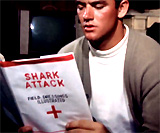
Robert August Reading: "Shark Attack - Field Dressings Illustrated"
|
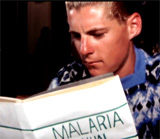
Mike Hynson Reading: "Malaria Manual"
|
- Brown then explained the premise of his film; two
surfers: 21 year-old blonde Mike Hynson and 18 year-old brown-haired
Robert August (as Themselves), professional wave chasers, planned
to travel around the world in search of two things: an "endless
summer" season and "the perfect wave"; the night before
the surfers began their trip, they prepared by humorously reading
issues of National Geographic, a book titled "African
Folk Tales," "Africa
on 9 cents a Month," "Shark
Attack, Field Dressings Illustrated," and a "Malaria
Manual";
they were also described packing for
the journey: "Packing for the journey was important. Six
pairs of trunks, two boxes of wax, some modern sounds, and
in case of injury, one band-aid"
- the two carried their surfboards through a parking
lot at Los Angeles International Airport on a cold, foggy, winter
morning in November, for the first leg of their journey around the
world; on the plane, the narrator thoughtfully
asked: "On the plane heading to Africa, Robert wondered what
was in store for them. Would they find surf? Would they catch malaria?
Would they be speared by a native? He didn't have any idea"
- the incredible surfing footage followed the two
surfers as they traveled (seen in a world-map graphic) from Los
Angeles to - Senegal (Dakar), and then on to Ghana (Accra), Nigeria
(Lagos), South Africa (Cape Town and Durban), Australia (Perth,
Melbourne, and Sydney), New Zealand (the Auckland and North Island
area), Tahiti (Papeete), Hawaii (Oahu) and finally back to California
- their first stop was in Senegal (Dakar),
where they were informed after arriving at the airport (as Africans
carried their surfboards) that they had no choice but to stay at
a government-owned hotel or leave the country; the "primitive"
African accommodations - tongue in cheek - were actually in a multi-story
luxury hotel along the seashore, at an unbelievable rate of $30 dollars a day each:
- "As you walk through
the front door, they stamp SUCKER on your forehead. The joke
turned out to be on the government, however, because right out
in front of this hotel was a little island about a quarter mile
off shore. And off each end of this island was surf breaking,
surf that no one had ever ridden before, and as far as we know,
no surfer had ever even seen before"
- as the surfers warily approached the beach in Senegal
with their surfboards, they were wearing similar swim-suits and
carrying similar surfboards; after being
in Africa for only four hours, they were surfing waves that were
much better than those in California, and the water was warmer;
the narrator also commented on how some of the local kids watched;
after navigating rocks and having some cool rides, the narrator
explained: "It was so expensive in Dakar, Senegal,
they decided to leave. A cup of coffee cost the
equivalent of one American dollar in Senegalese francs"
- they traveled 2,000 miles
further south to Accra in Ghana, also on the African coast, where
no one had ever seen a surfboard; at first, they had trouble explaining
to locals how to transport their surfboards from the airport to
their hotel - they ended up with the boards sticking out of the
trunk of a taxi; they were nervous as they tried out the beach
near a primitive fishing village in Ghana, not knowing how the
locals would react to them:
- "Most of these people had never seen a
white man before. As they walked down the beach, they really
wondered if they were doing the right thing. Didn't know whether
the UN had been there or not. They were a little nervous on
the beach so they paddled right out into the water. Paddling
out, they had the horrible thought that maybe surfing would
violate some religious taboo of the natives and they'd attack.
During the first ride, the hundreds of natives were dead silent,
but when Robert pulled out, they really went wild. That was
the beginning of surfing in Ghana. The people couldn't believe
it. They came down to the beach with their kids and their lunch
and still had both hands free"

Surfing at a Primitive Fishing Village in Ghana
|
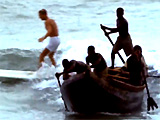
Surfing Near a Massive Fishing Canoe in Ghana
|
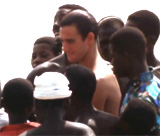
Robert Surrounded by African Natives
|
- the surfers were also amazed how the locals
wanted to try out their surfboards, and often not relinquish
the boards; they also marveled at how the locals would pick up surfing
fairly quickly, due to their familiarity with the ocean, and their
own massive, hollowed-out fishing canoes; the natives quickly learned
one US phrase: "HANG 10!" - repeated as they went out fishing in one of the canoes;
the people surrounded Robert, curious about him without knowing a
word of English; some were so excited they ripped boards from their
shacks and used them as belly boards; the two surfers also provided
free surfing lessons for the young boys and became friendly with
the Chief, who never had a problem with acquiring the board
- the next surfing location was Lagos, Nigeria, where
they hitched a ride to find a place where "no one had
ever surfed before"; in the surf, they encountered
very "HOT" conditions:
"When I say 'hot' in this case, I don't refer to the
shape of the waves, but to the actual temperature of the waves. The
water temperature here in Nigeria, almost on the Equator, was an
unbelievable 91 degrees. It melted the wax right off the board.
The air temperature was about a 100. The humidity felt like 5,000
per cent. It felt dryer underwater than it did up there in the air";
the narrator mentioned that if one stepped on a stonefish in Nigeria,
you would be dead in 15 minutes
- once they finished surfing, they hiked back through
a tropical jungle in order to hitch a ride back to town; it was "full
of all kinds of creepy things, snakes, spiders. They expected Tarzan
to come swinging by on a vine"
- after their short visit to Nigeria, the surfers
boarded a South African Airways plane to take them to South Africa
(Cape Town and Durban); during a sightseeing trip via gondola to
the top of Table Mountain, they looked down on the Cape of Good
Hope, a landmark separating the Pacific Ocean from the Indian Ocean;
a caravan of about 100 locals surfers all driving in VWs joined
Robert and Mike for a day of surfing at the same spot; they also
hooked up with some of the females for sunbathing
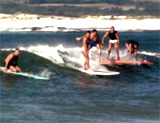
South African Locals Surfing in a Group
|
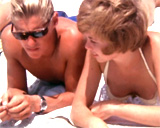
|
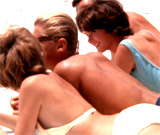
|
|
Mingling with the Female Locals
|
- after their time in Cape Town to get away from
crowded surf conditions, the two borrowed a car and drove down
the Cape's coast looking for other isolated surf spots; the narrator
described the desolate features of the roads and beaches along
the way; in some places in S. Africa, the beaches were so pristine and deserted
that it seemed scary: "You pass many beaches with not
a soul on them, not a footprint in the
sand, and there hasn't been one in 10 years. You can be so alone
on the beach down there, it's almost scary"; on the Atlantic
Ocean side of the Cape, they paddled out to the kelp-rich surface
that had the effect of cutting down the size of the waves, in water
that was only 54 degrees; on the Indian Ocean side of the Cape,
the water could often be 20 degrees warmer
- they proceeded 1,200 miles up the coast to the Indian
Ocean coastal town of Durban, S. Africa; as they awaited a hitched
ride sitting by the side of the road, Mike flashbacked on surfing
at the dangerous "Wedge" located at Newport Beach, CA ("Where you
catch waves you didn't even want!...")
- after hours of waiting,
they were picked up by a local chap (a snake-handler and animal
catcher for zoos) named Terence Bullen (as Himself) who offered
to take them on a journey of over 2,000 miles over a two-week period;
Terence wasn't a surfer, but instead was skilled at milking
venom from poisonous cobra snakes: ("he handles
over a 1,000 deadly cobras a week"); they marveled that they could
just pull off the road and go surfing at any number of exceptional
surfing spots without names and under "perfect conditions"
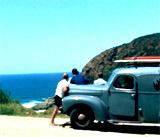
|
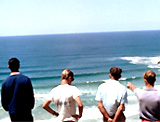
|
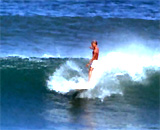
|
|
Hitchhiking and Stopping Unnamed Surfing Spots
Along the Roadside on the Way to Durban, S. Africa
|
- as they drove through the countryside toward Durban,
they marveled at the wildlife during their adventures, easily spotting
a large elan, a herd of impala, giraffes, mischievous monkeys,
and a kicking wild zebra; they also visited a local Zulu village
- once they arrived in the tropical city of Durban,
the sun rose at 4:30 am and it would only get hotter; Bruce Brown
narrated how the warm water would cause a tremendous problem with
sharks; he also spoke about the unusual Speedo-styled bathing suits: ("They
call their bathing suits down there costumes - in America we call
this thing a g-string!"); he delivered warnings about
surfers who ventured beyond the netted main beach areas:
- "If you go in the water away from the
main beach, the odds are 50-50 you'll be killed by a shark.
This beach is meshed and netted against sharks, but even
here you keep your eyes open. You look over the top of a
wave and see a fin coming toward you, your heart stops.
If you're swimming, you really wish you weren't"
- however, it was only a false alarm;
the fins that the surfers saw were from a group of "friendly
porpoises"; the narrator then continued with a slightly dated
and politically tinged comment: "Everyone's happy to see the
porpoises because when they're around they seem to keep the sharks
away. Sharks and porpoises have yet to integrate in South Africa"
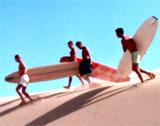
|
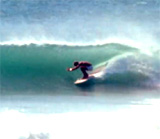
|
|
Treking Across Sand Dunes to Get to the "Perfect
Wave"
|
- in fact, they did experience a 'perfect wave' at
their last surfing spot - Cape St. Francis in S. Africa; it was
a 3-mile trek across sand to get to the water - and included was
a brief shout-out to "Terence of Arabia" (referencing the 1962
film); the narrator spoke of the rarity of discovering a "perfect
wave":
- "When you go looking for surf, you don't
look for a really big wave. If you found one, you'd never ride
it in strange waters. It would be much too dangerous. What
every surfer dreams of riding is a small wave with perfect
shape - what we call a perfect wave. The odds against finding
that are ten million to one"
- a 45 second wave was ridden by Mike on his first
try:
- "On Mike's
first ride, the first five seconds, he knew he'd finally
found that perfect wave. The waves looked like they had been
made by some kind of a machine. The rides were so long, I couldn't
get most of them on one piece of film....A perfect wave and perfect
conditions. The only disadvantage was that you'd get cramps in
your legs from squatting down for so long in the curl. The thing
you can't show is the fantastic speed and that feeling you get
in the pit of your stomach. It's the kind of a wave that makes
you talk to yourself. I couldn't help but think of the hundreds
of years these waves must have been breaking here, but until
this day, no one had ever ridden one. Think of the thousands
of waves that went to waste and the waves that are going to waste
right now, at Cape St. Francis. Out of the whole day of surfing,
we didn't see one wave section or break in front of itself. Each
wave - was perfect"
- there was a quick detour to look at fancy footwork
on a board in Hawaii, and some veering off to compliment a female
surfer in a two-piece suit (including a 'chest protector') who
was riding the waves at Haleiwa Beach on the North Shore in Hawaii:
("Lots of girls surf in Hawaii and many of them are very good.
Taking off outside in the green "chest
protector" - Bernie Ross")
- the narrator spoke about the near-ideal temperatures
in Hawaii's surfing: "Although by the
calendar it's winter time in Hawaii, the water is 75 degrees and
so is the air. The temperature only changes about two degrees during
the year, so unless you have sensitive skin, you can't tell whether
it's winter or summer in Hawaii. Hawaii is truly a land of an endless
summer"; there were also views of catamarans sailing off the
Ala Moana Beach Park area: ("Whether you like to surf or sail,
or surf and sail both, Hawaii even in the winter, is truly a land
of an endless summer")
- after their experiences in Durban,, S. Africa, the
surfers headed toward Johannesburg, to catch a plane to Perth in
Western Australia; as they traveled with some of Australian "blokes"
to find some very poor surfing spots on sometimes impassable roads,
they often heard the same refrain: "Everywhere
they went, they were greeted with a familiar cry surfers have heard
a thousand times each. 'You guys REALLY missed it, you should've
been here yesterday!'"
- at the beautiful but deserted "Ocean Beach" (near
the town of Denmark) without much surf action, they
experienced serious issues with some Australian sharks: "We
call them sharks, the Australians call them 'the Men in the Gray
Suits.' Whatever you call them, they like your body"; soon
after, they journeyed onward to Melbourne on Australia's southern
shore to hopefully find better conditions; they joined local surfers
to drive 60 miles to Bells Beach on the SW Australian coast, where
the surf wasn't great, so they just mingled with the beachfolk
- they discovered that Australian flies were very
problematic: "You go onto the beach and there are 30 flies assigned to your
body. When you leave they go back to Command Headquarters and wait
for another assignment"; they were also told that the best conditions
at Bells Beach were in the winter-time - about 6 months away in July;
traveling around, they realized that it was hit-or-miss on finding
good surf spots
- the narrator commented about
the nature of competitive Australian surfers: "The Australians
are very competitive surfers. They always like to do one better
than the 'Yanks' as they call us. So, if you go out and 'Hang 5',
they'll go out and 'Hang 10'. If you 'Hang 10', they'll do one
better which is something like 'Hang Body'"
- the two surfers
were told they might strike better surf conditions at Sydney, Australia,
but such was not the case: they found 3 foot wind chop, 1 foot
waves, and 3 inches of rain; after being told that the conditions
were better earlier, Robert spoke out about the usually great and
"big" conditions at Waimea Bay in Hawaii:
- "When Waimea Bay in Hawaii gets big,
it's a whole specialized part of surfing. They'll sometimes sit
and watch it for a couple of hours before going out. If it
gets too big and closes out, the closest place you can get
ashore is 20 miles away. Special boards are used called 'big-guns.'
You have to wait for a lull in the shore break before you can
even try to get out. Sometimes you'll stand there for half
an hour, waiting for a chance to get through this shore break...Only
a handful of surfers actually ride these big waves. Some of
them are sportsman, some of them are nuts. Waimea Bay on the
north shore of Oahu in Hawaii...."
- during a detour and side-story as Robert bragged
about the awesome might of the waves in Hawaii, the narrator spoke
about the fantastic and intense power of the wave action; he mentioned
how surfers had to take precautions against a dangerous
runaway surfing board due to the strong waves:
- "The most dangerous thing with a big wave
is to get hit with your board or someone else's board. A surfboard
hurdled with the force of one of these waves can cut you in half.
So, the most common sight you see at Waimea is surfers diving
off, trying to get away from their board under water to safety.
They're diving in awkward positions, literally diving to save
their own lives. When you see one of
these big waves letting down in front of you, your heart's beating
so fast you can do a standing broad jump of fifteen feet and not
even know it. Just paddling out can be a national disaster. You
take off, make the steep drop, hear the white water rumbling
behind you, and feel the spray in your back, you see you're going
to make it into the safety of the shoulder, it feels like the
happiest day of your life. Waimea Bay has only been
ridden since 1958, when the first group of surfers challenged
it. Yet surfers watched it break for 10 years before going out.
Can you imagine the courage it took to be the first? If
you could harness the power of one of these waves, you can light
a city for a week"
- although Robert and Michael balked at surfing in
Australia at first, they decided to follow one of the bikinied
female surfers into the ocean; the narrator mentioned how Australian
life-guards had to take precautions for female surfers who often
lost their suits: "When the girls get wiped out they have some trouble losing
parts of these suits. The darn thing's are so little they roll up
in a ball and go down a clam hole or something and they never find
them again. The life guards down there carry spare bathing suits.
Carry fifteen in a band aid box"
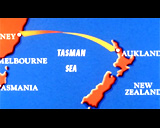
Next Stop: Auckland, New Zealand (North Island)
|
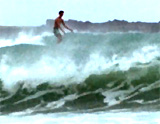
Surfing on New Zealand's Northwest Coast (North Island at Ahipara)
|
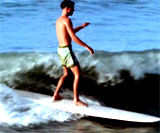
A Long Surf Ride at Raglan, NZ
|
- the next stop in the adventurous journey was travel
to Auckland, New Zealand, where surfing on the east coast was under
mild conditions while it was more "rugged" on the west coast, with
strong winds of 20 knots making for "poor surfing"; they took a
driving trip to the northwest tip of the North Island to the isolated
town of Ahipara and its Bay with its usually deserted Ninety Mile
Beach; after surfing, they also went camping and fishing and caught
some 4-5 pound rainbow and brown trout
- their next destination was Raglan, NZ, a west coast
beachside town, with a large cove
(with breaking surf) and a wrap-around black sand beach; they went
surfing there on Christmas Day; Robert was viewed taking a really
long ride into the cove, as the narrator sarcastically explained:
- "Once the novelty of the long ride wears off,
it gets kind of boring. You start talking to yourself, reciting
poetry, yodeling, anything to keep your mind occupied. This is
the shore break. It only lasts about 15 minutes. You go out
for surfing for the day at Raglan, you get two rides,
one after breakfast, and one after lunch; if you try for three,
you starve to death. Surfers here don't carry wax, they carry
life-raft rations"
- the two surfers began to start reminiscing about
their entire trip after their day of surfing at Raglan, with unpredictable
and mixed surfing results:
- "Drying off after the day of surfing
in the afternoon summer sun of New Zealand, they remarked to
each other how ironic their trip had been so far. In Africa,
where they really didn't expect to find surf, they found such
good waves. In Australia, that has good surf, they'd been unlucky
and hadn't gotten anything. Here in New Zealand, they had a
few pretty good days, but they knew it could have been even
better. That's what it's like when you're following the summer
around the world, looking for places to surf"
- their next stop was the French Polynesian island
of Tahiti, where it was well-known that the barrier reef
surrounding the island cut off the larger waves, but made for crystal-clear
water in its lagoons; they did find one surfing spot with
small but well-formed waves, and part of the island's coastline
(without the reef) also had good surfing:
- "Everyone said there was no surf in Tahiti,
but they had already found some, so, they thought they'd better
drive around the island and take a good look. Off they went
to the famous town of Papeete. You get to one side of the island
and you find everyone's wrong. There is surf in Tahiti. There's
no barrier reef at all on one side of the island. There's all
kinds of surf rolling into the black sand beaches. Just a matter
of finding the right beach, with the right bottom contours,
the right swell direction, and you'll find a place to surf. We
found an interesting spot. We called it 'Ins and Outs' because
you could ride the wave in - or you could ride the wave out.
The wave going out had better shape than the wave did coming
in, so they spent most of the time riding out"
- to their surprise, they found the best wave in Tahiti
was closeby at "The Other Spot" during a rain squall: "The best
waves came through right in the middle of a rain squall. It was
kind of weird when it rained. The rain was 75 degrees. The water
was 75 degrees. The air temperature was 75 degrees. It was so pleasant
it almost made you sick to your stomach"
- at their final surfing location back in Oahu, Hawaii
during the winter season, the narrator spoke about how the
waves at the "Pipeline" on the North Shore could reach terrifying and
dangerous heights:
- "Good old Hawaii and the good old nasty Pipeline.
This is a surfing spot that's hardly even a surfing spot. It's
more like a Roman gladiators pit. So dangerous it almost defies
description. The way the waves break is bad enough, but, it's
also very shallow and on the bottom is coral - not the usual
formation, but coral that sticks up like big overgrown railroad
spikes. You hang onto your board. You go over the falls with
it every time - guaranteed. Any wipeout at the Pipeline
is a bad one. At most places, when someone gets wiped out, everyone
watching on the beach laughs. No one laughs at the Pipeline. They
wait and see if you come up again....You
ride this place with a different attitude. You don't want to fool
around. You want to make that wave more than anything in the world..."
- during one surfer's ride at the "Pipeline," his
board split in half: "You can drive a car over a surfboard and
it won't break. But a wave at the Pipeline can easily snap one
in half"
- Robert's and Mike's journey was coming to a close
in Hawaii, as Bruce Brown recalled their amazing adventures:
- "They couldn't help but think back to the many
things they'd already seen and done, the animals, and especially
the 'perfect wave' they discovered and rode at Cape St. Francis
in South Africa. They missed these things, but there wasn't
a much better place to be than Hawaii. In a couple of months
when the season changed, they'd return with the summer season
to their homes in California. With enough time and
enough money, you could spend the rest of your life following
the summer around the world. But, for now, the endless summer
must end. This is Bruce Brown. Thank you for watching. I hope
you enjoyed my film"
|

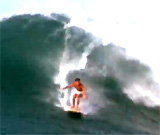
The Popular Summer Sport of Surfing
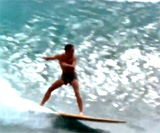
Avoiding a Wipe-Out with a Wide Stance
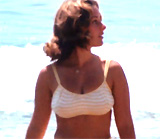
"A Girl" at a Surfing Beach in Malibu, California
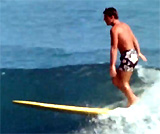
The Perfect Position For a Surfer: Stay in the Curl
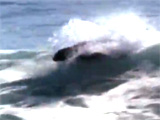
Henry - A Body-Surfing Seal
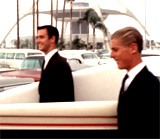
At LAX - The Beginning Of the Surfers' Journey Round the World
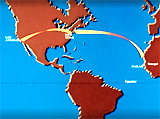
Map Graphic - First Leg of Journey From Los Angeles to Senegal (Dakar)
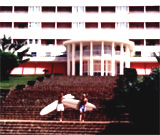
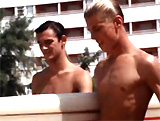
Carrying Their Surfboards Out of Their Dakar Luxury Hotel
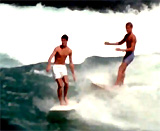
Their First Surf Ride in Senegal
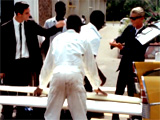
Problems Transporting Surfboards From Ghana Airport to Hotel
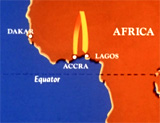
Next Stop After Ghana: Lagos in Nigeria
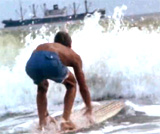
Surfing in "Hot" Weather Conditions in Nigeria
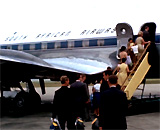
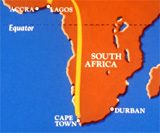
On the Way to South Africa (Cape Town)
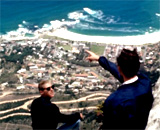
Sight-Seeing: On Top of Table Mountain in Cape Town
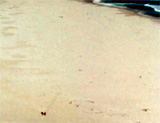
Two Miniscule Figures on a Pristine and Isolated S. African
Beach, Known as Long Beach
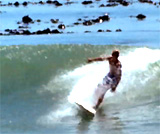
In Kelp-Rich Waters On the Atlantic Side of the Cape
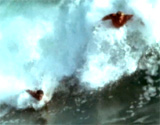
Flashback: Dangerous Surfing at "The Wedge" at Newport Beach, CA
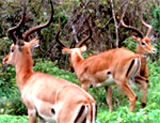
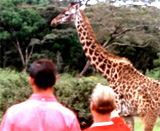
Examples of Wildlife in S. Africa: A Herd of Impala and
Giraffes
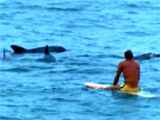
Durban, S. Africa: "Friendly Porpoises"
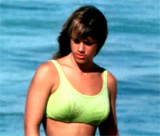
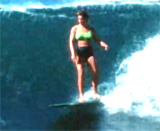
Haleiwa Beach in Hawaii: A Surfer With a Green "Chest
Protector"


Next Stops in Journey, Perth, Melbourne and Sydney in
Australia
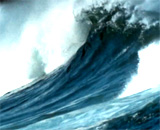
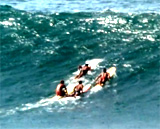
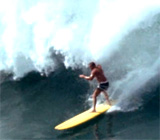
Side-Story:
The Massive Waves Breaking Onto the Shore at Waimea
Bay, Hawaii - a Major Challenge for Surfers
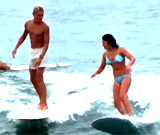
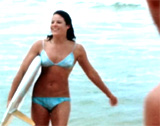
Sydney, Australia: Surfing and Making Friends With Bikinied
Females
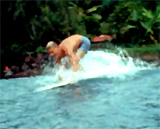
Riding a Wave "Out" at the "Ins and Outs" in
Papeete, Tahiti
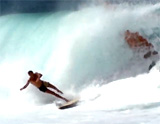
Surfing the Dangerous "Pipeline" On Hawaii's (Oahu's)
North Shore
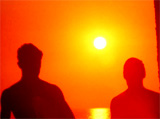
The End of the Journey - A Search for an "Endless
Summer"
|




































